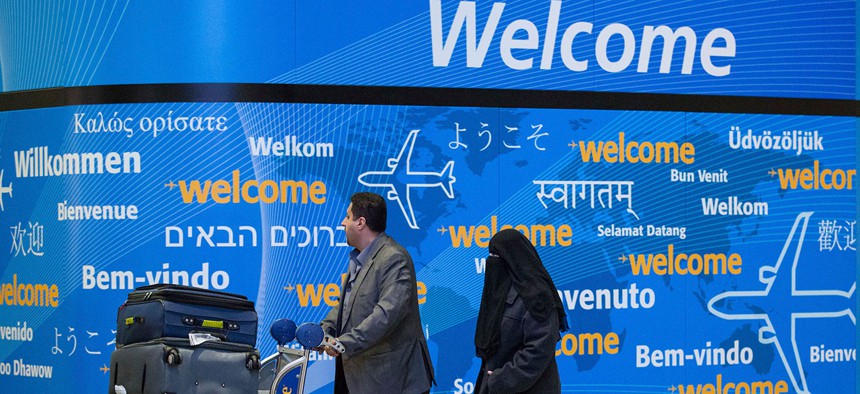
Passengers walk out of an entrance after their arrival at Terminal 4 at John F. Kennedy International Airport in New York in February. Alexander F. Yuan/AP
Inside Trump's Newest Travel Ban
The administration enacted new restrictions on foreign travel on Sunday as key parts of its previous order expired.
The Trump administration rolled out a new version of its controversial travel ban on Sunday, permanently restricting entry into the United States from eight countries just hours before part of the previous ban would have expired.
Five of the affected countries—Iran, Libya, Somalia, Syria, and Yemen—fell under the previous ban. The new order adds new barriers to entry for nationals of Chad, Venezuela, and North Korea to the list of restrictions. Of them, only Chad is a Muslim-majority nation like the others targeted in the original ban. Sudan, which was covered under both previous iterations of the ban, was not included in the latest edition.
“Making America safe is my number one priority,” President Trump wrote on Twitter shortly after announcing the new restrictions. “We will not admit those into the country we cannot safely vet.”
Restrictions are tailored differently for each country, a departure from previous versions of the ban. Nationals from most of the countries will be largely denied immigrant and some non-immigrant visas going forward. For Venezuela, the impact will likely be minimal: The order only suspends tourist and business visas for some Venezuelan security officials and their families. At the same time, it bars U.S. entry by virtually all North Koreans and Syrians who don’t fall within a general set of exceptions, like travelers holding diplomatic visas or those granted asylum.
Critics of the travel bans said the new additions described the order as a third version of the Muslim ban Trump proposed during the campaign.“Six of President Trump's targeted countries are Muslim,” Anthony Romero, the ACLU’s executive director, said in a statement. “The fact that Trump has added North Korea—with few visitors to the U.S.—and a few government officials from Venezuela doesn't obfuscate the real fact that the administration's order is still a Muslim ban.”
The order doesn’t apply to lawful permanent residents or any foreign national currently within the United States. In addition to exemptions for travelers with dual nationality and refugees already admitted into the U.S., it also allows consular officials to waive restrictions for Canadian permanent residents, children and adoptees, travelers seeking medical care, students and workers with significant U.S. ties who happened to be outside the country when the order was enacted, among others.
The new restrictions for the eight countries came hours before a key portion of President Trump’s previous version of the ban was set to expire. Under that iteration, the State Department suspended visa applications from six Muslim-majority countries for 90 days while the federal government conducted a worldwide review of border-security standards. The 90-day clock began in late June when the U.S. Supreme Court allowed a modified version of the ban to go into force.
On a conference call with reporters on Friday, administration officials said they developed the new standards as part of the review, and in close coordination with countries around the world. Some, but not all, of the measures are borrowed from existing programs like the Visa Waiver Program, which allows visa-free entry into the country for 90 days from the European Union and other close U.S. allies. Other restrictions are aimed at potential terrorist threats from countries lacking either the will or the ability to screen prospective travelers, the officials said.
According to the order, countries had to meet a “baseline” of information sharing with the U.S. to avoid restrictions: identity verification for prospective travelers, access to criminal-history records, and risk assessments of travelers’ potential risk to public safety. Seven of the restricted countries did not meet the baseline; Somalia, the eighth, met it but also had “significant identity-management deficiencies.”
In addition, the order said Iraq “did not meet the baseline,” but added that restrictions like those faced by other countries “are not warranted,” citing close relations with the Iraqi government and a large U.S. government presence there. Iraqi leaders expressed outrage when the country fell under the first version of the travel ban in January; a diplomatic campaign by Baghdad led to its removal from the second iteration in March.
The new rules are the product of a joint effort between the State, Justice, and Homeland Security Departments, as well as the Trump White House. Going into the weekend there were few clues about what the restrictions would look like.
On the Friday call, officials from the State, Justice, and Homeland Security Departments declined to offer any details about their recommendations to Trump, when exactly the new parameters would be announced, and the countries that would be affected. They also did not comment on how the restrictions would affect—or be affected by—the ongoing legal struggles surrounding earlier versions of the ban.
The updated ban comes roughly nine months after the administration first attempted to constrict foreign entry. The original executive order, released in January, suspended U.S. entry for refugees worldwide and virtually all foreign nationals from seven Muslim-majority countries, including travelers on student and work visas. Some green-card holders were also briefly barred from re-entering the United States until John Kelly, the secretary of homeland security at the time, personally intervened.
Chaos ensued. The order’s sudden rollout—late on a Friday night without any warning—led to turmoil at major airports across the country. Some travelers found themselves barred from entering the United States mid-flight. Protesters and lawyers soon gathered at transit hubs like Washington’s Dulles and New York City’s John F. Kennedy airports to aid those who had been stranded. By the following Monday, multiple federal judges had temporarily blocked the ban’s enforcement while legal challenges went forward.
After the Ninth Circuit Court of Appeals ruled against the original ban’s constitutionality in February, the Trump administration said it would rewrite the order. Trump himself vented on Twitter about judges who ruled against the ban, claiming the judiciary would be responsible if another terrorist attack occurred. The second version barred new visa applications instead of U.S. entry, removed Iraq from the list of countries affected, and added numerous exceptions to its restrictions. It also dropped the indefinite ban on Syrian refugees while suspending new refugee admissions for 120 days.
But shortly before the revised order was set to go into effect in March, federal courts sided with immigrant-rights groups who asked them to halt its implementation. The Fourth and Ninth Circuits eventually forbid its core provisions from going into force in the months that followed. In reaction, the administration vowed to appeal the rulings to the Supreme Court. The justices agreed to hear the case on the last day of the 2016-2017 term in June and set oral arguments for when the Court reconvenes next month. Until then, the Court allowed most of the visa-application restrictions and the refugee-admissions freeze to go into effect.
It’s unclear what will happen next for the pending Supreme Court case, Trump v. International Refugee Assistance Project, now that the 90-day period has passed. On Sunday night, the Justice Department asked the Supreme Court to request additional briefs from both sides of the case on what steps to take next. Oral arguments in the case are currently scheduled for October 10.







